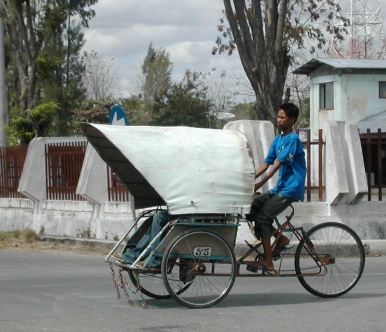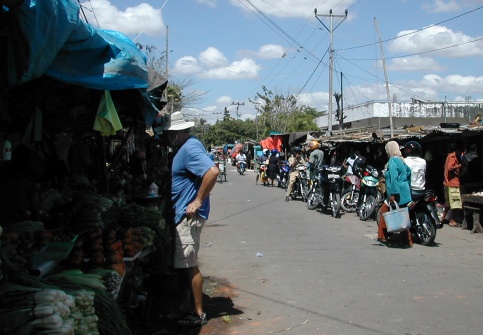SUMBA
Sailing to Sumba from Roti was an uneventful overnighter. We were both miserably tired from our rolly night on Roti, so we both napped well throughout the day and night. We arrived at Waingapu on the east coast of Sumba midday the following day.
The harbor at Waingapu is primarily a fishing port; however, there are two small docks to which ships can tie to load and/or off-load. Unfortunately for us, there was a ship there off-loading cement just upwind of us for two days. The anchorage area is small, deep, and lacks good holding due to trash on the bottom. We got a secure bite on our second try in 42 feet of mud.
We thought that we were required to check in with any available officials at every port we visit (this adds to our affection for uninhabited places) – even if only a village head. We knew that Waingapu would have the entire collection of customs, immigration, quarantine, etc., and we were not up to facing them. So we stayed on board that afternoon to rest and recuperate, and we postponed dealing with the officials until the following morning.

Daytime public transportation
Waingapu is when we first realized how thoroughly unprepared we were to deal with the language barrier in Indonesia. So far, we have always been able to find a few people whom spoke at least a little English, and we have gotten by. However, very few Indonesians in the outer islands speak and/or understand any English at all. We not only do not speak Indonesian, we did not even have a phrasebook on board.
Just finding customs/immigration/et al was an experience. We could not explain who we were looking for, so the friendly locals could not direct us. We stopped at every building that flew a national flag, and we found them on our fourth stop. Neither customs nor immigration nor the harbormaster spoke any English, but the quarantine officer did, so we got checked in after some awkward moments.
We roamed around through the old part of town near the harbor, and it was a dry dusty place. There were a few small shops, but this clearly was not a tourist Mecca. We later learned that only one or two sailboats stop at Sumba each year. We wandered in to what seemed a hardware store, and the proprietor spoke English! This was when we met and befriended Hiel.
Hiel advised us on what we ‘must see’ and how to go about seeing it. He said we must see the stone tombs at Rende, and he would arrange for us to get a bus to go there. We were to return to his store the following morning.
We returned the following morning ready for a day’s adventure. Hiel asked someone to drive us to his brother’s store where we could wait for the bus to take us to Rende and back. We waited for over an hour for the bus (his brother and family spoke no English), but it finally came. We boarded it, and we headed off for more of an adventure than we had bargained for.
The buses stop anywhere at anytime. You want something to drink? The bus will pull over and wait for you to go buy something. Need to do some shopping? No problem. If you can somehow get it in or on top of the bus, they will carry it for you – dead or alive.
After circling town for about an hour, we headed south toward Rende. We drove through some beautiful countryside with emerald green rice paddies surrounding palm trees along the coast. It was, however, a very long drive. We were growing a bit concerned that we would not get back to the boat before dark, and we had not turned on any lights.
We arrived at Rende at 3:30 in the afternoon. We stepped off the bus with camera in hand planning to take a few quick pictures then reboard the bus and return to Waingapu. We were handed our backpack and told “tomorrow” (a word known to many Indonesians). Tomorrow? But we need to return today! “Tomorrow”, and the bus drove off.
There are a few stone tombs, but we suddenly didn’t much care about them. We needed to find a way back to Waingapu before ‘tomorrow’. Of course, there was no phone, no place to eat, no place to sleep, etc. We asked around frantically for anyone that could speak any English, and one woman whom was weaving could speak a few words. She understood where we were trying to go, and she said, “bus on street”. We ran down the hill with shoes in hand hoping to catch the next bus. We waited a while with no bus in sight, so Bud walked back up the hill to try to get more info. And the bus arrived (the last bus of the day). Nita was not going to leave without Bud, but she also wasn’t going to let that bus leave without both of them on board. How to stall when you cannot speak the language…

The market and MANY motorcycles
We did both get on the bus, and the experience just got richer. The top of the bus was packed with bags and people. Inside the bus the aisle was full of 10 gallon jugs of fuel (unknown variety). Some jugs had screw on lids; some just had a piece of a plastic trash bag tied around the opening. This was a bit disquieting because nearly everyone on the bus was smoking. The bus was crowded with an interesting variety of people – crying baby, coughing sick woman, sleepers. There was also a generous spray of dried blood inside the bus, but it could have been from any sort of livestock as well as a person, so we chose not to worry about it.
There were two seats open – one near the front and another a few rows further back. Bud took the forward seat, and Nita went aft. The seats were little more than aged springs. Some had remnants of cloth and foam around the springs, some did not. Bud was overjoyed to find an English-speaking nun in a nearby seat, and he had his travel companion. Nita was less fortunate. She was sitting between a large woman who rolled her own cigarettes and two live chickens. The chickens were on top of one of the fuel jugs in the aisle.
As the bus picked up more passengers, one man gave up his seat, and he went forward and shared the driver’s seat – two men in the driver’s seat. Although they were crowded, we weren’t worried about him falling out because the door was tied shut. Chicken man gave up his seat, and he hung out the side door – a common practice. The woman next to Nita reached out the window opening (no actual window, of course) and plucked a large feather from one of the chickens. She stripped most of the feather. She used the stripped end to pick her teeth, and she used the remaining tuft of feather to clean her ears.
Somewhere along the way we had to stop to tighten the lug nuts on the wheels, and we had delays for livestock in the road. But a few hours later, and well after dark, we were back in Waingapu – somewhere.
We didn’t know where we were, we didn’t know how to get back to the port, and we didn’t know how to say so in Indonesian. We eventually found one young man who knew a few words of English, and he convinced us that he knew where we wanted to go. So we crawled on the back of two motorcycles (local taxi) and headed off. Within a few minutes we were obviously headed the wrong way, but Bud somehow communicated ‘fish market’ to his driver, and they headed a new direction. It would be difficult to describe our relief when we started seeing familiar sights.
When we got to the port, one of the locals was watching our dinghy for us. We found Passage in the dark (follow the cement cloud), and we were very very glad to get back on board.
The following day we went to the local market to buy a few fresh vegetables before leaving Sumba. It was a large market, but we were not particularly impressed with the quality or selection of veges. We also thought the vendors were a bit aggressive. We got a few things, and we stopped to say ‘good bye’ to Hiel. He, and another two men we had met, wanted to see Passage before we left, so we made arrangements to bring them out to the boat in the afternoon. None of them had ever been on a boat like ours before, and they seemed to really enjoy seeing it. We had enjoyed making new friends on Sumba, but we were very ready to move on.
Follow us to the Komodo/Rinca Islands or return to our Indonesia page.